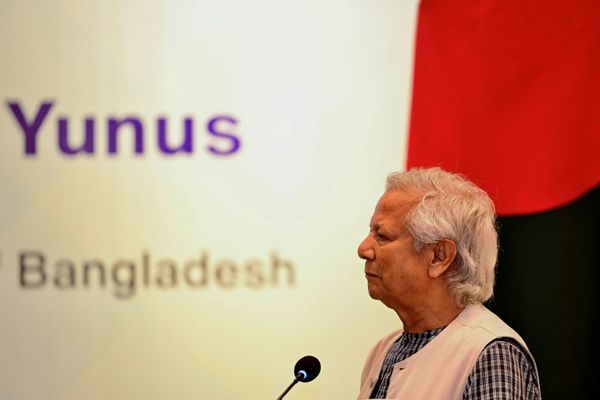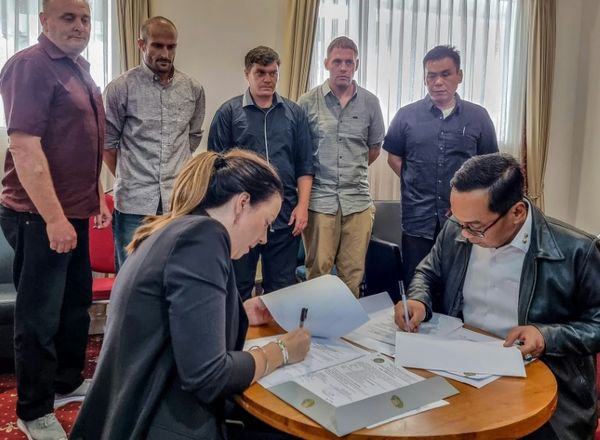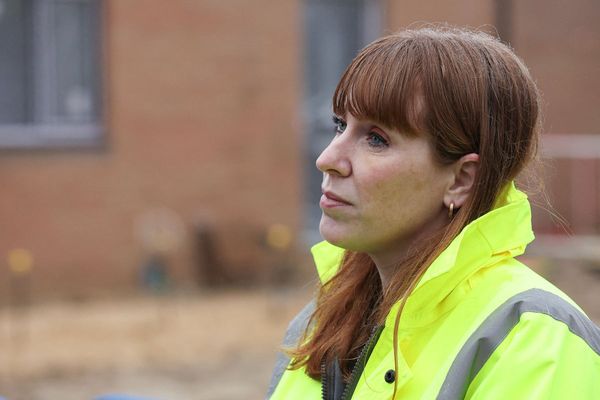
World War III, this time with multiple nuclear-armed states.
That’s the nightmare scenario haunting many people as Russia’s horrific war on Ukraine metastasizes, moving toward NATO’s borders, stoking further Western involvement, sucking in other powers, and spurring nuclear threats from President Vladimir Putin. Discussion of the conflict is rife with comparisons to the Cold War’s darkest days.
We are undoubtedly living through dangerous times, and the risk to Ukrainians is obviously grave. But to better understand the nature of the peril we face, it helps to dig deeper into history. The lesson: For the wider world, in terms of the chances of direct conventional or even nuclear war pitting Russia against the United States and its NATO allies, this is not the most precarious moment since the lowest points of the Cold War—at least not yet.
That was the consensus of several Cold War historians I corresponded with. On balance, they gave me some reason to temper my alarm about the war on Ukraine spiraling into a broader conflagration between nuclear-armed powers. Of the six historians I consulted, four said the present moment was less dangerous than the Cold War’s most hazardous moments; one said it was equally dangerous, just in different ways; and one said it was more dangerous.
The scholars emphasized how close the Soviet Union and United States came to nuclear war during the Cuban missile crisis, as a result of several factors that so far aren’t at play today. Most noted the reassuring ways in which the Biden administration is aiming to avoid an escalatory confrontation with Russia. But they also stressed that escalation stemming from mistakes or miscalculation, which was the most salient source of danger during the Cuban missile crisis, poses a significant risk now as well.
And several cited troubling reasons—including how prolonged the current crisis is likely to be, and modern-day Russia’s weakness compared with the Soviet Union in every domain but nuclear-weapons power—for why the eruption of hostilities in Ukraine may have ushered the world into uncharted territory, limiting the utility of historical analogies and rendering the present moment potentially more precarious.
Certain dynamics that made the Cuban missile crisis so treacherous are, at this point, absent in the conflict over Ukraine. Whereas the 1962 incident was sparked by the U.S. discovery of Soviet efforts to deploy nuclear-capable ballistic missiles to Cuba, today Russia has not taken a comparable step to directly threaten vital American interests, such as relocating “nuclear missiles closer to the U.S. or West,” Mary Elise Sarotte, a professor at the Johns Hopkins School of Advanced International Studies, told me.
The Harvard political scientist Graham Allison, who co-wrote a book, Essence of Decision, on the Cuban missile crisis, also drew a distinction between the brinkmanship 60 years ago and President Joe Biden’s determination to keep his confrontation with Putin from sliding “into hot war between U.S. and Russian forces that could escalate to World War III.”
To illustrate his point, Allison asked me to imagine some alternative history: It’s the last Saturday of the Cuban missile crisis, with tensions thick after an American spy plane was shot down. Instead of accepting the U.S. government’s proposed deal for the Soviets to swiftly remove their nuclear missiles from Cuba in tacit return for a U.S. pullout of similar missiles from Turkey, Soviet Premier Nikita Khrushchev rejects the offer.
In the event that Khrushchev rebuffed his ultimatum, President John F. Kennedy had approved strikes against the Soviet missiles and then an invasion of Cuba. What he didn’t know at the time: The 40,000 Soviet forces deployed to the island possessed more than 100 tactical nuclear weapons, relatively low-yield, short-range arms that can be used on a battlefield. Catastrophe could have ensued.
Near the end of the crisis, Kennedy put the odds that it would result in nuclear war at “‘between one in three and even,’” Allison said, adding that “nothing historians have discovered since has done anything to lengthen those odds.” By contrast, Allison estimates the probability that the Ukraine crisis will devolve into nuclear war between Russia and the United States as “less than one in 100—and in my best estimate, closer to one in 1,000.” Despite “Putin’s nuclear saber-rattling,” Allison judged it “extremely hard” to “sketch a scenario from the current tragedy to Russian nukes exploding on American soil.”
Sergey Radchenko, also at the Johns Hopkins School of Advanced International Studies, pinpointed the decision by the United States and NATO to explicitly rule out engaging in a direct conflict with Russia over Ukraine as the main reason the current war is less perilous than both the Cuban missile crisis and the lower-profile 1983 Able Archer incident, when the Soviets had twitchy fingers on the nuclear trigger during a U.S.-NATO military exercise that they feared could be cover for a preemptive U.S. nuclear strike. (To get a sense of the high-stakes jitters around the time of Able Archer, consider that a month earlier, a Soviet duty officer named Stanislav Petrov had, in the span of five frantic minutes, correctly determined that a satellite warning of incoming American intercontinental ballistic missiles was a false alarm, narrowly averting a nuclear calamity.)
The historian Melvyn Leffler similarly felt that the Western policy to not directly use force against Russia in Ukraine has reduced the chances of escalation with Moscow today relative to the worst crises of the Cold War, when each side was highly uncertain about what the other might do militarily. (He referenced not just the Cuban missile crisis but also the Soviet blockade and U.S.-British airlift, in 1948; the follow-on standoff over the status of Berlin, in 1961; and the U.S.-Soviet confrontation that accompanied the Yom Kippur War.)
A couple of the historians, however, expressed greater worry. Michael Dobbs, the author of One Minute to Midnight, an account of the Cuban missile crisis, told me that the debate about whether Putin is a “rational actor” misses the central lesson from the 1962 incident. Kennedy and Khrushchev were “rational actors,” he noted, “but they still brought the world to the edge of the nuclear abyss” because of mistakes and miscalculations.
Echoing concerns from Radchenko and Leffler about inadvertent escalation, Dobbs listed various forms that these missteps could take today: a warplane straying over NATO or Russian borders, a confrontation between naval forces, a cyberattack gone awry. And whereas the Cuban missile crisis transpired over just 13 days, Russia’s military intervention in Ukraine has already lasted longer than that with no clear end in sight, and numerous signs point to further escalation, increasing the likelihood of blunders.
Vladislav Zubok, at the London School of Economics, told me he views Russia’s invasion of Ukraine as more dangerous than episodes such as Able Archer and the Cuban missile crisis. Not only is Putin less politically constrained than his Soviet predecessors, who had the politburo to reckon with, but he is also presiding over a country that is far weaker than the Soviet Union was in its heyday, producing a uniquely destabilizing dynamic.
The weakness of Russia’s conventional military and economy, now on vivid display, has likely produced “cognitive dissonance” among Russian leaders, who consider their country a great power but are confronting a reality that suggests otherwise, Zubok noted. Recent weeks have revealed “that they don’t have very many cards to play” in terms of “conventional forms of power,” but there is one domain in which Russia remains a superpower: nuclear weapons. Zubok’s fear is that a cornered, existentially threatened Putin will use nuclear weapons as the “ultimate joker [card] that can change the game.” Perhaps in the future we will discover records showing that Putin was bluffing with his nuclear taunts, he mused, “but something tells me this is not the story.”
Zubok’s comment reminded me that although applying historical lessons to contemporary circumstances has value, an asymmetry of analysis is at play. Historians can access a wealth of information about the periods they study—declassified documents, oral histories—that we simply don’t have in our foggier present.
And the fog of this war is heavy with possible hazards.
For four decades during the Cold War, with a nuclear sword of Damocles hanging over their struggle, the Soviet Union and the United States and its NATO allies sought to avoid direct military conflict with one another, instead waging war through proxies. Yet developments such as the recent Russian strike on a Ukrainian military facility near the border with Poland, a NATO member, and the Kremlin’s threat to target Western weapons shipments passing through that area raise the specter of a head-on conflict between nuclear-armed adversaries. The very definition of a direct clash, and even whether we’re already engaged in one, is up in the air as the United States and Europe effectively prosecute a financial war against Russia in reaction to Putin’s assault on Ukraine.
Nuclear weapons were never used during the Cold War in substantial part because of the belief in both Washington and Moscow, as Ronald Reagan put it when describing the logic of mutual assured destruction, that “a nuclear war cannot be won and must never be fought.” But the world’s fragile system of nuclear deterrence could crumble, as the writer David French warned, if Putin decides that the only way he can win against Ukraine and the West is by making use in some form of his advantage in tactical nuclear weapons. This might not generate the sort of nuclear conflict envisioned by some of the historians I turned to—with nukes raining down on U.S. or NATO territory and Western retaliation in kind—but it would still be a nuclear conflict.
Although several historians favorably cited the move by the United States and NATO to exclude the possibility of a fight with Russia over Ukraine, that approach too could have hidden costs. It means Putin can conduct his war without worrying about a response from Western conventional or nuclear forces; the terrible trade-off for less concern about a direct conflict between Russia and the West may be a higher probability of the Kremlin escalating its aggression against Ukraine.
And whereas the Cold War materialized relatively gradually in the years after World War II, a new iron curtain—sweeping in its economic, diplomatic, political, informational, and digital dimensions—is now descending with unprecedented speed. As Sarotte, at Johns Hopkins, fears, that could potentially leave two nuclear-armed powers largely operating in isolation from each other.
In comparing Ukraine today with the Cuban missile crisis, Dobbs arrived at a grim calculation. “The risks of a direct confrontation between U.S. and Russian forces may be fairly low at present,” he conceded. “But if you multiply that by X months or X years and the number of things that could go wrong, they turn out to be similar mathematically.”







